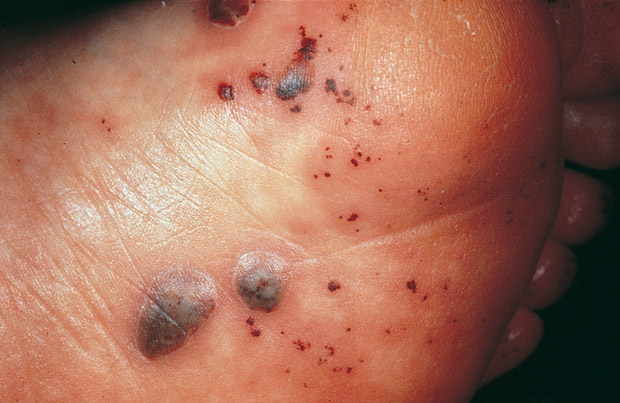MKSAP Quiz: 4 days of fever and arthralgia
A 43-year-old man is evaluated for 4 days of fever and arthralgia, as well as a raised purple rash over his lower extremities of 1 week's duration. He is a current intravenous drug user. He has no other medical problems and takes no medications.

On physical examination, temperature is 37.8°C (100°F) and blood pressure is 132/85 mm Hg; other vital signs are normal. The large and small joints are tender to palpation without evidence of synovitis. The abdomen is not tender to palpation. The liver edge is palpable below the right costal margin. The skin findings are shown.
Laboratory studies:
| Alanine aminotransferase | 143 U/L |
| Aspartate aminotransferase | 130 U/L |
| Total bilirubin | 2.2 mg/dL (37.6 µmol/L) |
| Creatinine | 1.0 mg/dL (88.4 µmol/L) |
| Hepatitis B surface antigen | Positive |
| IgM antibody to hepatitis B core antigen | Positive |
| Hepatitis B e antigen | Positive |
| HBV DNA | 10,000,000 IU/mL |
| Hepatitis C antibody | Negative |
| HIV-1/HIV-2 antigen and antibody combination immunoassay | Negative |
| Cryoglobulin | Normal |
| Urinalysis | Normal |
Which of the following is the most appropriate treatment?
A. Entecavir
B. Plasma exchange
C. Prednisone and cyclophosphamide
D. Sofosbuvir and ledipasvir
E. Tenofovir, emtricitabine, and raltegravir
Answer and critique
The correct answer is A. Entecavir. This item is Question 25 in MKSAP 18's Gastroenterology and Hepatology section.
The most appropriate treatment is entecavir. Hepatitis B virus (HBV)–related polyarteritis nodosa (PAN) is the most likely diagnosis in this patient. The patient has fever, arthralgia, and evidence of cutaneous vasculitis (rash). There is also evidence of hepatitis (elevated bilirubin and aminotransferase levels) likely related to his use of intravenous drugs. Testing for hepatitis B surface antigen and hepatitis B e antigen is positive, as is IgM antibody to hepatitis B core antigen, with a significant HBV DNA viral load; all of these results are consistent with a recent HBV infection. PAN and mixed cryoglobulinemia are rare HBV-associated vasculitides. This patient has undetectable serum cryoglobulins, excluding the diagnosis of mixed cryoglobulinemia. There are no data from randomized trials to guide therapy in patients with HBV-related PAN. Patients with HBV infection and mild manifestations of PAN are usually treated with antiviral agents such as entecavir. Patients (such as this one) with mild PAN have constitutional symptoms, arthritis or arthralgia, anemia, and skin lesions. More severe disease is characterized by organ dysfunction (for example, myocarditis, kidney insufficiency and hypertension, mononeuritis multiplex) or life-threatening systemic manifestations. Patients with severe manifestations of PAN are often treated with an antiviral agent and a short course of prednisone and plasma exchange.
Prednisone and cyclophosphamide are agents typically used to treat mild and severe manifestations of idiopathic PAN, the most commonly recognized form of PAN. Because this patient has HBV-related PAN, treating the causative viral infection with an antiviral agent is the preferred management.
Sofosbuvir and ledipasvir are direct-acting antiviral agents used to treat hepatitis C virus (HCV) infection and would be an appropriate choice for mild HCV-related PAN. However, this patient's hepatitis C antibody is negative and these agents are not indicated.
Tenofovir, emtricitabine, and raltegravir are used to treat HIV infection. This drug combination would be an appropriate choice for HIV-related PAN, but the patient's HIV test is negative and these agents are not indicated. Tenofovir alone would be a reasonable treatment for this patient.
Key Point
- Mild hepatitis B virus–related polyarteritis nodosa is treated with antiviral agents.




